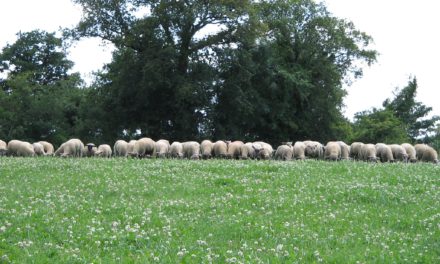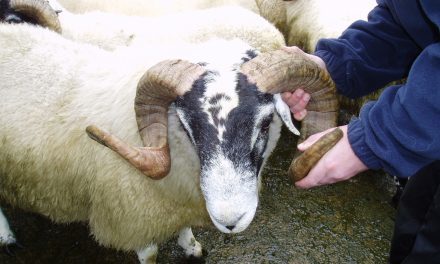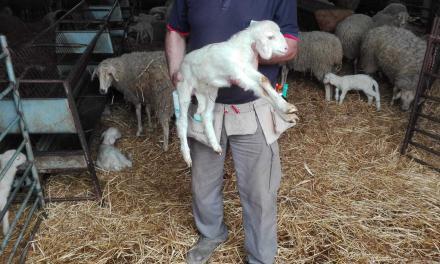This post is also available in:
![]()
![]()
![]()
![]()
![]()
![]()
Control of Ovine Progressive Pneumonia (Maedi Visna) at farm level
Solution name: Control of Ovine Progressive Pneumonia (Maedi Visna) at farm level
Aim: Our aim is to give clear instructions for the control of Maedi Visna in farms, which can be applied in practice and have been tested in the flocks of ELGO-DIMITRA.
Description:
Ovine Progressive Pneumonia (Maedi/Visna) belongs to the group of Iceberg diseases. Since there is no treatment or vaccine, the only way to control the disease is to apply specific management strategies at farm level.
Progressive Pneumonia is a slow-growing disease of sheep and goats that leads to progressive weakness and eventually death. It is caused by Lentivirus strains of the Retrovirus family. The main source of infection is considered to be the intake of colostrum by an infected mother. The virus affects several organs leading to clinical disease with signs such as: respiratory symptoms, the manifestation of arthritis (“swollen” joints), mastitis (hard and swollen udder) and and/or neurological signs. The disease progresses slowly and clinical symptoms are observed in older animals (usually older than 2 years). It is widespread in Europe providing serious threat for the sustainability of the sheep sector. This is a major issue especially if we take into account that in some farms, the infection rate exceeds 60%. It is therefore necessary to take immediate measures to reduce and gradually eliminate the disease and to draw up programs according the acquired experience.
Topic: health/management
Production: Dairy / Meat
Animal Category: Adult / Lamb / Replacement
Issue: Iceberg diseases – Maedi Visna
Level of Solution: Knowledge, Practical
Country: Greece

How to implement it
VRI researchers, trying to limit the spread of the disease in Greece, propose a program that has 2 main objectives:
- The early diagnosis of infected animals. The diagnosis is based on the clinical manifestation of the disease and is confirmed in the laboratory by serological tests to detect antibodies of the virus. However, because antibodies are usually found in animals older than 2 years, PCR-based diagnostic protocols have been proposed that detect the virus itself or its precursors before the antibodies appear.
Two disease control strategies are proposed depending on the flock prevalence:
- Infection rate less than 10% – “examination and slaughtering” of positive animals and their offspring.
- Infection rate greater than 10% – immediate removal of new-borns from their mothers, administration of colostrum from healthy animals (or from cows or commercially available immunoglobulin preparations or commercial colostrum for lambs) and application of artificial feeding. It should be emphasized that for the success of the program it is important to keep the replacement animals in a separate place and to avoid their contact with the adult.
- The detection of animal genes associated with disease resistance or susceptibility (research in Greece is at a very early stage)
Expected benefits
The expected benefits of Visna Maedi control are:
– additional revenue due to the added value of disease – free breeders
– reduced consumption of chemotherapeutics (antibiotics)
– possibility of increasing milk production, better growth of lambs and improvement of animal welfare.
Cost Benefit analysis
The Maedi Visna eradication / control program is expected to increase the milk yield and the farmer’s income. The extra costs for the artificial feeding, estrous and lambing synchronization, technical advice and vet services are overcovered by the additional income that the farmer achieves.
Sustainability analysis
As a consequence of the increase of milk production after Maedi Visna eradication/control, the farmers could decrease the numbers of animals and the environmental indicators, and the atmosphere could be benefit by this reduction in the flock number. The improvement of the environmental indicators could be additionally enforced from the reduction of the animal antibiotic consumption.
Concerning the other benefits, the animal welfare, the “image” of the farmer and the environment will be also improved after eradication/control of Maedi Visna, because the farmers that will apply the eradication protocol will have a healthy and more productive flock at the end, that gives them the opportunity to increase the production with less animals.
Prerequisites and/or limits
Due to the high mutation rate of the virus, the detection of infected animals by PCR might lead to false negative results. Combination of serology and molecular methods seems to be the most effective diagnostic procedure. Maedi Visna eradication requires a long time. Early diagnosis is very important to take the necessary remedial measures. A prerequisite is the existence of housing facilities with enough room so that the flock can be divided into 2 groups raised separately at the beginning of the protocol implementation (infected animals in one group, healthy animals in the other group). Furthermore, farm personnel must be informed and trained for specific animal handling.
Information Source / Usefull links
- Εκτροφή προβάτων και αιγών: Τι πρέπει να ξέρω; ΕΛΛΗΝΙΚΟΣ ΓΕΩΡΓΙΚΟΣ ΟΡΓΑΝΙΣΜΟΣ – ΔΗΜΗΤΡΑ, Ινστιτούτο Κτηνιατρικών Ερευνών, Θεσσαλονίκη 2017 ISBN: 978-960-98079-2-0
- Tsiligianni, E. Ntovolou and G. S. Amiridis. Synchronization of lambing with low doses of dexamethasone. Acta Veterinaria Hungarica 56(3):393-397 (2008).
- Tsiligianni, E. Dovolou, G.S. Amiridis. Efficacy of feeding cow colostrum to newborn lambs. Livestock Science 149:305–309 (2012).
- Θ. Τσιλιγιάννη και Ε. Βαϊνάς. Οικονομικές επιπτώσεις από την Προϊούσα Πνευμονία στα πρόβατα – Απλοποιημένα σχήματα Εξυγίανσης. ΕΘ.Ι.ΑΓ.Ε. Τριμηνιαία Έκδοση του Εθνικού Ιδρύματος Αγροτικής Έρευνας, Τεύχος 26:12-17 (2006).
- https://issuu.com/grafeiotypou.elgo
- https://www.vri.gr/el/content/οικονομικεσ-επιπτωσεισ-απο-την-προϊουσα-πνευμονια-στα-προβατα






